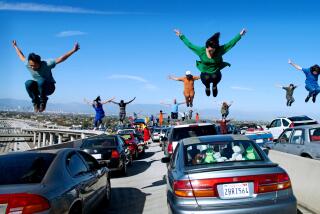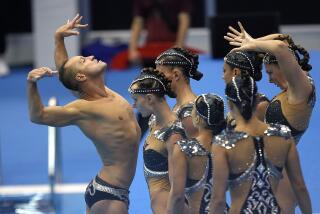Swimming / Tracy Dodds : Meet at Austin Takes On Some Major Changes
- Share via
What used to be the U.S. Swimming International Meet has undergone some major changes. It has been moved from the first weekend in January to the first weekend in December. It will be a long-course meet so that world records can be set. And it has been reorganized to include scoring for club teams, college teams and international teams.
It will be interesting to see how different coaches and swimmers approach the new meet, which will be held in the very fast Texas Swim Center at Austin next Friday, Saturday and Sunday.
UCLA Coach Ron Ballatore, for example, says his team is going at it “full blast.”
USC Coach Peter Daland is sending just two swimmers.
Daland doesn’t want to interrupt his swimmers’ short-course training as he looks ahead to conference and then NCAA competition in April.
“I think the idea of the meet is good,” Daland said. “I’m strongly in favor of the idea as being in the best interest of U.S. Swimming. But it’s not in the best interest of SC right now to train for that meet.”
Ballatore has used the meet as the focal point for a different type of training schedule this year.
The UCLA swimmers came in early this fall and have been training, all along, for the long-course meet along with their short-course training. They have had five dual meets so far, and four have been long course. Usually, collegiate swimmers stick to yards throughout the school year.
“For years we’ve been trying to get the NCAA to let us have both a long-course championship and a short-course championship,” Ballatore said. “But the NCAA never wants to spend any money on swimming. This gives us the chance to compete both ways. It’s kind of like the difference between cross-country and track, but we’ve only been able to compete in one.
“We’ve never had the chance to compete, as UCLA, in a long-course meet. We’re taking this chance seriously. We have a chance to win the meet. I think Florida is taking the same approach.
“It’s a great pool, and I think we’ll have some great times. . . . The kids on the U.S. team have to shave for the meet, and I think that will affect the others’ approach.”
Most college coaches will be hesitant to work their swimmers hard this early, though. Most want to work them very intensely over the Christmas break.
“We’re trying something new this year,” Ballatore said. “We came in early and worked hard. We’ve been looking forward to this meet. Then I’m going to give them Christmas off. We’ll come back at the start of January and work nothing but short course.
“I’m hoping that it has the opposite effect of burning them out. I’m hoping that it means they have something to get excited about now, have a good rest and then come back ready to go hard again.
“Our women’s team is training with the same philosophy.
“I guess we’ll see at this meet and over the next few months whether it was a good idea or not.”
At least 17 nations will compete in the meet next weekend, including the East German team that did not compete in the Olympics in 1984.
Italy will be represented by one swimmer--Giovanni Minervini, who also will be competing for UCLA.
Tom Jager of UCLA, who was originally included on the U.S. team, had to be replaced on that team when Ballatore decided to compete for the team title. The only conflict lies with the relays. In all of his individual events, his points could have counted for UCLA, but the U.S. team and UCLA both needed him to swim on relays.
Nancy Hogshead has not been doing much swimming lately. Not much left to prove after her golden performance in the ’84 Olympics. But she has been very busy. Besides being a fulltime student at Duke, she’s been working for the National Women’s Sports Foundation and, lately, she’s been traveling all over the country representing Glaxo, the company that makes an asthma product called Ventolin.
“It sounds incredible, but I found out at the Olympics that I had been swimming for all those years with exercise-induced asthma,” Hogshead said. “It had never been diagnosed. My own father is even a doctor. But the fact that I was always breathing hydrated air and the fact that I have just a humongous lung capacity had been masking it.
“There were times when I would pass out after a competition, but I thought that was just from the exertion.
“I wish I had known it and had been able to treat it. . . . I was going for the medal that would have given me more medals than any other swimmer at the Olympics--and over the last 200 meters, I could not breathe. It was scary. I wish I had known about the condition and about this product.
“Now I’m going around trying to make people realize how much you can do, physically, even with asthma. Did you know that 66 Olympians had asthma in ‘84?
“What I want people to know is that there is an asthma product that is allowed for the Olympics.”
Ever since Rick DeMont lost his gold medal because of an asthma medicine, there has been an attitude that no medication is allowed.
“That doesn’t have to happen ever again,” Hogshead said.
More to Read
Go beyond the scoreboard
Get the latest on L.A.'s teams in the daily Sports Report newsletter.
You may occasionally receive promotional content from the Los Angeles Times.










